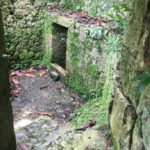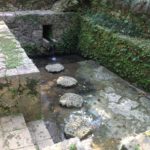森 mori: woods
川 kawa: river/water spring/well
There are many locations in Japan and even Korea where the “celestial maiden” (or also known as “heavenly maiden”) myth takes place; one such place happens to be in Ginowan 宜野湾, Okinawa at Mori-no-kawa 森の川 (also written as: 森川). Tennyo 天女 mean “heavenly maiden” in Japanese. Tennyo-chan also happens to be the city mascot for Ginowan, so you see her image quite a bit in the area.
**In Ryukyuan language 森の川 is actually pronounced “Mui-nu-kaa” ムイヌカー. Though I have honestly never heard anyone call it that, I have only heard the Japanese pronunciation.
Mori-no-kawa Spring is surrounded by a small forested park, with a few monuments explaining the heavenly maiden legend. The spring (known as a ヒージャーガー hiijaagaa in Okinawa language) is considered somewhat of a sacred place where people would gather water for cooking, drinking, laundry, etc; often in Okinawa you will see small altars here. Sacred spots are called utaki 御嶽 in Ryukyuan language, and are oftentimes located at a water spring, mountain, woods, cave, or other natural geologic feature.
In Mori-no-kawa park, you will see a stone wall with a gate leading to the woods– do not try to enter this area, it is an utaki! It is considered sacred, and only priestesses are usually allowed in there. Oddly, it is also right next to the border with Futenma military base, which actually protects it from potential land developers who would mow it over for a luxury resort, high-rise apartment, or golf course. The wall and gate kind of reminds me of a “secret garden” entrance, sort of mystical and such, with all the thick forest behind it.
I have heard rumors that Mori-no-kawa is both a “power spot” and a “haunted spot.” Perhaps I will post the ghost stories of this location sometime. Either way, it is indeed has the air of a spiritual place.
The Legend of Hagoromo (羽衣 hagoromo: celestial robe): A long time ago a farmer (in other stories he is a woodcutter) named Ufuya Okuma was on his way home when stopped by the Mori-no-kawa (spring); to his amazement he saw a beautiful woman, a celestial being, bathing in the water. Not too far away was her celestial robe (called “hagoromo”) hanging on a tree branch. The farmer decided to take her heavenly garment and hide it. When the celestial maiden discovered her robe had mysteriously vanished she was upset since she could not return to the heavens without it. Ufuya returned and came to the “rescue” of the distressed woman, clothed her, and took her into his house, basically tricking her. Since she could not return home to the heavens, she became the farmer’s wife and later gave birth to two children, a boy and a girl. Legend says that one day the maiden heard her little daughter singing a lullaby, “Don’t cry baby. Toubins-hanin’s (angel’s wings) are hidden in the storehouse under the millet. Don’t cry baby.” The maiden rushed to the storehouse and there she found her hidden celestial robe. She immediately left to return to the heavens, never to return again.
What became of her daughter is not really certain, but legend is that the son grew up and became a great king, King Satto, a once great king of the Chuzan region, the central area of the Ryukyu Kingdom during the 14th Century. This is the Ryukuan legend of the celestial robe.
Every year in Ginowan, during the summer, is the Hagoromo matsuri, in part celebrating the legend, but also the culture of the town.
address: 1 Chome-20-6 Mashiki, Ginowan, Okinawa Prefecture 901-2224
https://goo.gl/maps/aSURx8ii8dG2








2 thoughts on “Ryukuan Legend of the Celestial Maiden”
Comments are closed.